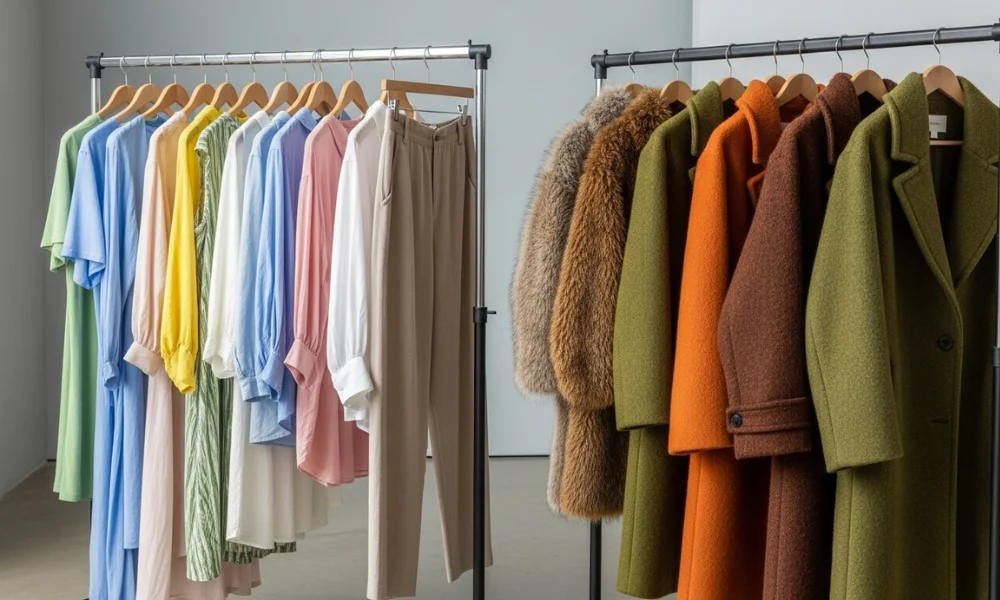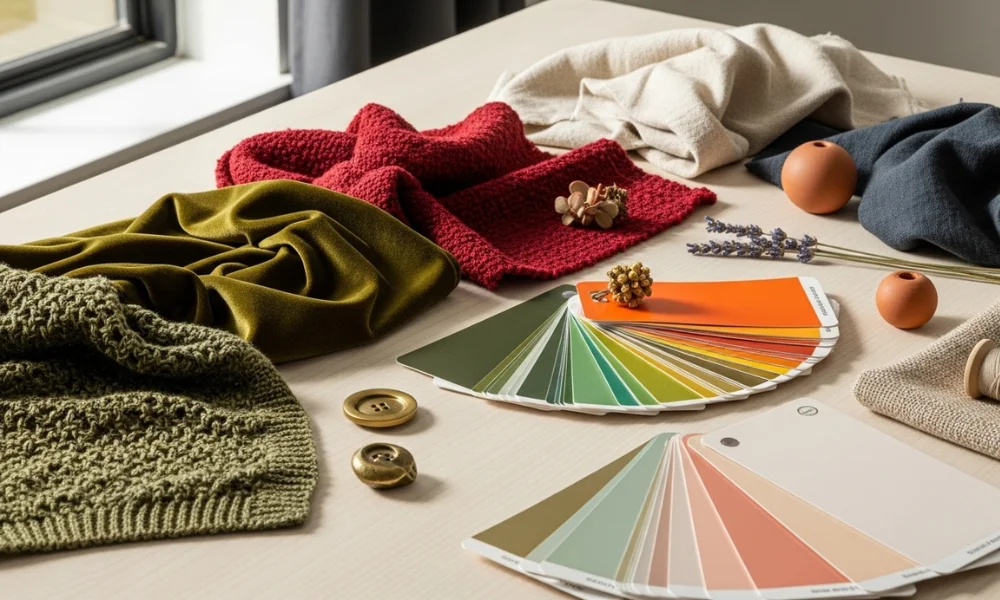Fashion now faces urgent calls to unite creativity and environmental responsibility worldwide. Pravi Celer explores major sustainable fashion trends changing designer seasons during 2025-26. This guide explains eco materials, ethical production, and seasonal style transformations.
Readers gain actionable insights on sustainable designer fashion across Spring/Summer and Autumn/Winter seasons.
Understanding Sustainable Fashion Trends
What Sustainable Fashion Trends Really Mean
Sustainable fashion trends go beyond using recycled or organic materials only. They include fair labour practices, transparent supply chains, and reduced global production waste. Designer brands integrate these practices as core strategies, not just marketing tactics. This shift creates deeper trust between designers, consumers, and environmental advocates alike.
Key Drivers Behind Sustainable Fashion Trends
Consumer demand for transparency and environmental care now shapes brand decisions. Innovations in bio-fabricated fabrics and recycled textiles accelerate adoption everywhere. Governments introduce regulations requiring clear disclosure of impacts and practices. Seasonless design cycles reduce waste and encourage the adoption of capsule wardrobes worldwide.
Seasonal Forecasts for Sustainable Designer Fashion

Spring/Summer 2025 Designer Sustainable Styles
Lightweight natural fibres dominate: organic cotton, linen blends, and TENCEL fabrics. Colour palettes show soft pastels, botanical greens, and luminous neutrals with accents. Silhouettes become flowy, minimal layering, and breathable shapes define collections. Designers highlight natural dyes and low-impact finishes in runway presentations.
Autumn/Winter 2025-26 Designer Sustainable Motifs
Heavy fabrics appear: recycled wool, faux eco-fur, and thick sustainable knits. Rich warm tones like deep olive, spiced orange, and chocolate brown dominate. Textured surfaces such as velvet, suede, and boucle create tactile interest. Outerwear includes statement coats with zero-waste linings and ethical fur alternatives.
Seasonless and Trans-Seasonal Designer Approaches
Seasonless fashion is emerging as a key sustainable trend in the global fashion industry. Designers release capsule pieces that are wearable across both Spring/Summer and Autumn/Winter seasons. Neutral colour families and adaptable silhouettes encourage longer garment life cycles. This approach reduces waste and reshapes traditional fashion calendars globally.
Seasonal Sustainable Fashion Trends at a Glance
| Season | Key Sustainable Fabrics | Dominant Colour Palettes | Signature Styles & Features | Eco-Techniques Used |
|---|---|---|---|---|
| Spring/Summer 2025 | Organic cotton, linen, TENCEL, hemp blends | Soft pastels, botanical greens, luminous neutrals, subtle accents | Flowy silhouettes, minimal layering, breathable cuts | Natural dyes, low-impact finishes, zero-waste cutting |
| Autumn/Winter 2025-26 | Recycled wool, faux eco-fur, biodegradable heavy knits | Deep olive, spiced orange, chocolate brown, rich berries | Statement coats, textured knits, eco outerwear | Ethical fur alternatives, recycled trims, circular sourcing |
| Seasonless / Trans-Seasonal | Versatile fabrics, regenerated silk, plant-based leather | Neutral tones, adaptable accents, timeless hues | Capsule wardrobes, mix-and-match layering, modular garments | On-demand production, rental/resale integration, supply chain transparency |
This table gives readers an instant view of how sustainable fashion trends manifest across designer seasons.
Innovations in Materials and Techniques
Bio-Fabricated and Plant-Based Materials
Plant-based leathers from mushrooms and apples emerge strongly in designer collections. Brands such as Mats Rombaut prove that eco materials can deliver luxury aesthetics. Natural fibres like hemp, linen, and bamboo are gaining renewed attention worldwide. These innovations reduce environmental harm while maintaining global style integrity.
Recycled and Upcycled Textiles
Recycling ocean waste into yarn now supplies premium fabrics for designers. Upcycling deadstock materials and vintage textiles has become a mainstream high-fashion trend. Zero-waste pattern cutting minimises scraps in production. Recycled polyester blends enhance the softness, drape, and durability of garments.
Sustainable Dyes, Finishes, and Colour Techniques
Natural dyes, such as indigo, turmeric, and beetroot, replace chemical alternatives. Low-water dyeing and digital printing reduce water usage and pollution. Vegetable-based finishes add biodegradable glazes to accessories and trims. Ethical pigment sourcing forms a new narrative for sustainable luxury brands.
Circular Fashion and On-Demand Production
Circular fashion models expand rental, resale, and take-back programs. On-demand production cuts overstock and prevents unnecessary unsold garments. Slemphasizes emphasiemphasizesly, longevity, and mindful consumption everywhere. Designer brands embrace transparency by sharing supply chain data openly.
Designer Examples and Case Studies
Mats Rombaut: Footwear and Accessory Innovation
Mats Rombaut uses Piñatex, apple leather, and recycled fabrics for footwear. His collections show sustainable materials can deliver luxury aesthetics and bold shapes. Collaborations with larger brands demonstrate that style and conscience can work together successfully. Rombaut embodies sustainable fashion trends moving into mainstream designer markets today.
Indigenous Designers and Cultural Sustainability
Indigenous designers incorporate natural dyes, traditional weaving techniques, and heritage fibres sustainably and responsibly. They collaborate with artisans to preserve culture while reducing environmental impact globally. Runway presentations highlight ethics, beauty, and authenticity in each garment carefully. This diversity enriches sustainable fashion trends across global designer fashion scenes.
Upcycling Innovators and Emerging Labels
New labels transform deadstock textiles and waste materials into luxury fashion pieces. Patchwork couture and upcycled denim have gained significant runway attention worldwide this year. Some projects convert plastic waste into innovative wearable textiles for high fashion. These examples show creativity in solving persistent textile waste through designer innovation.
Colour Palettes, Textures, and Aesthetic Forecasts

Colour Forecasts for Upcoming Seasons
Spring/Summer 2026 will feature botanical greens, pastel peach, and luminous neutrals. Autumn/Winter emphasises berries, oranges, and deep browns strongly. Accent colours like teal, coral, and bright yellow provide lively contrast globally. Nature’s influence shapes sustainable fashion trends in both hues and mood boards.
Textural Trends and Fabric Feel
Soft textures appear: linen slubs, raw silk, and open-weave knits everywhere. Heavier textures dominate colder seasons: velvet, faux suede, and soft faux fur. Mixed textures create tactile contrast inside single garments for designer impact. Embroidery and 3D floral appliqués rise strongly in sustainable runway shows.
Sustainability and Ethics in Designer Production
Supply Chain Transparency and Ethical Labour
Brands are revealing their sourcing locations and working conditions more openly than before—certifications such as GOTS, Fair Trade, and OEKO-TEX are guiding conscious consumers worldwide. Design houses publish impact reports as standard practice across their websites. Ethical sourcing builds trust and loyalty among environmentally aware buyers worldwide.
Reducing Waste and Carbon Footprint
Zero-waste design methods significantly reduce fabric offcuts in production worldwide. Local sourcing reduces shipping emissions and shortens transport distances globally. On-demand manufacturing prevents the accumulation of surplus inventory in designer warehouses. Renewable energy adoption grows steadily within textile mills and fashion houses.
Consumer Behaviour and Market Shifts
Values-Driven Buying
Consumers increasingly choose brands that align with environmental and social values. They prefer eco-friendly labels rather than purely luxury status symbols today. Timeless pieces replace frequent fast-fashion purchases in many stylish wardrobes. Durability, repairability, and resale potential significantly influence buying decisions.
Rental, Resale, and Circular Access
Rental platforms and resale apps grow across major fashion markets worldwide. Designer items rented for events extend garment lifecycles and reduce waste. Circular access encourages responsible consumption and new audience engagement globally. Designers respond by creating rental-friendly, durable, and repairable collections.
Regional and Cultural Variations in Trends
Sustainability in Non-Western Designer Fashion
African, Asian, and Latin American designers integrate traditional crafts sustainably today. Nairobi Fashion Week showcases second-hand textiles and proudly celebrates local fabric heritage. Regional practices continually enrich global sustainable fashion trends with diverse aesthetics. Cultural knowledge fosters unique approaches to ethical designer fashion movements.
Climate and Season Differences Across Regions
Seasonal trends differ widely due to climate variations around the entire world. Tropical regions favour breathable fabrics year-round, avoiding heavy knits entirely. Polar or temperate areas require insulated materials for consistent warmth. Designers tailor collections to geography while firmly maintaining sustainability goals.
Challenges and Critiques of Sustainable Fashion Trends
Cost versus Accessibility
Sustainable materials often cost more to source and process effectively. Designer labels may price items high, limiting access for average consumers. Scaling ethical practices requires investment and collaboration across global supply chains. Cost remains a significant barrier to the widespread adoption of sustainable fashion.
Greenwashing and Authenticity
Some brands exaggerate sustainability claims without credible evidence or verification. Certifications may be missing, outdated, or confusing for conscious consumers. Transparency and third-party verification help avoid accusations of greenwashing globally, as informed buyers research practices beyond marketing slogans before making purchasing decisions.
Durability and Long-Term Impact
Eco-materials must remain durable enough to last through many seasons globally. Some bio-fabricated fabrics degrade too quickly under normal wear conditions. Repairability and quality are essential parts of real sustainability goals today. Lifecycle impact matters more than initial material sourcing alone consistently.
How Designers and Brands Can Implement Sustainable Fashion Trends
Strategic Materials Sourcing
Designers should seek suppliers of organic fibres, bio-fabricated leathers, and recycled and ethically sourced materials whenever possible globally. Conduct material audits for each seasonal collection to ensure responsibility is always maintained. Balance aesthetics with environmental footprint for every design decision carefully.
Seasonless Design and Capsule Collections
Create pieces functioning across multiple seasons to reduce unnecessary production volumes. Limit the number of seasonal drops while maintaining fresh styles globally today. Encourage mix-and-match wardrobes for extended use and fewer purchases worldwide. The capsule emphasises minimal waste and timeless appeal strongly.
Transparency and Community Engagement
Publish supply chain maps, material sources, and labour conditions openly everywhere. Engage communities and artisans in ethical work for mutual benefit globally. Share progress metrics publicly to consistently build consumer trust worldwide. Transparency strengthens authenticity and brand loyalty across markets strongly.
What Pravi Celer Predicts for 2026 and Beyond

Emerging Materials and Innovation
Pravi Celer predicts lab-grown fabrics, mushroom leather, and seaweed fibres entering runways. Biofabrication and regenerative textiles are expected to expand in designer collections worldwide. Technologies like 3D knitting are becoming increasingly sustainable and scalable globally. These innovations will soon deepen sustainable fashion trends across all luxury segments.
Hybrid Seasonal Cycles and Local Adaptation
Fashion calendars may blur further as climate and consumer demand shift quickly. Designers will adapt seasonal releases for local conditions and markets everywhere. Hybrid offerings and region-specific lines are expected to experience rapid growth worldwide soon. Flexibility enhances sustainability and reduces unsold stock accumulation globally.
Stronger Consumer Education and Ethical Choices
Consumers will demand clear explanations about the garment’s lifecycle and its global impact. Education on sustainable fashion trends will influence global purchase decisions. Brands must show proof through certifications, repair offers, and impact data now. Ethical fashion will soon define prestige alongside design innovation worldwide.
Conclusion
Recognises fashion trends as a powerful transformation of designer seasons today. From eco materials and seasonal palettes to circular production, ethics guide creativity. Designers and consumers both benefit by embracing transparency, durability, and conscience at all times. Follow Pravi Celer for future insights and choose fashion that honours beauty and the planet consistently.

